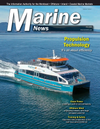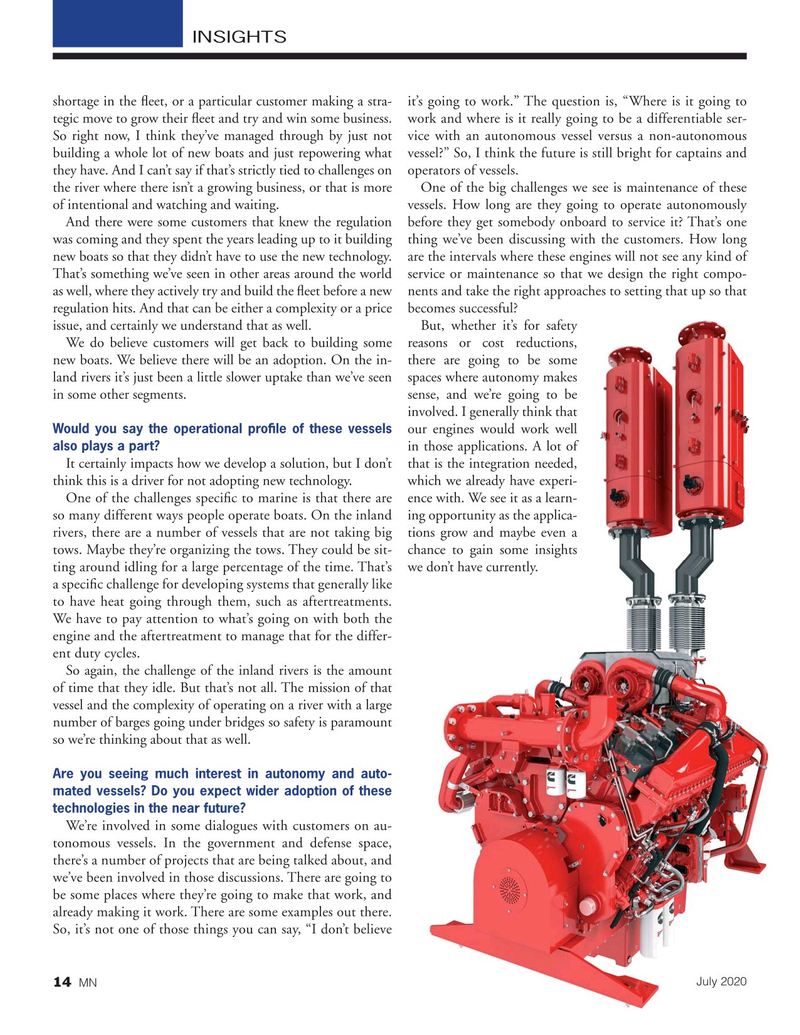
Page 14: of Marine News Magazine (July 2020)
Propulsion Technology
Read this page in Pdf, Flash or Html5 edition of July 2020 Marine News Magazine
).3)'(43 shortage in the ?eet, or a particular customer making a stra- it’s going to work.” The question is, “Where is it going to tegic move to grow their ?eet and try and win some business. work and where is it really going to be a differentiable ser-
So right now, I think they’ve managed through by just not vice with an autonomous vessel versus a non-autonomous building a whole lot of new boats and just repowering what vessel?” So, I think the future is still bright for captains and they have. And I can’t say if that’s strictly tied to challenges on operators of vessels.
the river where there isn’t a growing business, or that is more One of the big challenges we see is maintenance of these of intentional and watching and waiting. vessels. How long are they going to operate autonomously
And there were some customers that knew the regulation before they get somebody onboard to service it? That’s one was coming and they spent the years leading up to it building thing we’ve been discussing with the customers. How long new boats so that they didn’t have to use the new technology. are the intervals where these engines will not see any kind of
That’s something we’ve seen in other areas around the world service or maintenance so that we design the right compo- as well, where they actively try and build the ?eet before a new nents and take the right approaches to setting that up so that regulation hits. And that can be either a complexity or a price becomes successful?
ut, whether it’s for safety issue, and certainly we understand that as well. But, whether it’s for safety ons or cost reductions, We do believe customers will get back to building some reasons or cost reductions, new boats. We believe there will be an adoption. On the in- there are going to be some re are going to be some land rivers it’s just been a little slower uptake than we’ve seen spaces where autonomy makes ces where autonomy makes in some other segments. sense, and we’re going to be e, and we’re going to be involved. I generally think that olved. I generally think that
Would you say the operational pro?le of these vessels our engines would work well engines would work well also plays a part?
in those applications. A lot of hose applications. A lot of
It certainly impacts how we develop a solution, but I don’t that is the integration needed, is the integration needed, think this is a driver for not adopting new technology. which we already have experi-ch we already have experi-
One of the challenges speci?c to marine is that there are ence with. We see it as a learn-e with. We see it as a learn- so many different ways people operate boats. On the inland ing opportunity as the applica-opportunity as the applica- rivers, there are a number of vessels that are not taking big tions grow and maybe even a ns grow and maybe even a tows. Maybe they’re organizing the tows. They could be sit- chance to gain some insights nce to gain some insights ting around idling for a large percentage of the time. That’s we don’t have currently. don’t have currently. a speci?c challenge for developing systems that generally like to have heat going through them, such as aftertreatments.
We have to pay attention to what’s going on with both the engine and the aftertreatment to manage that for the differ- ent duty cycles.
So again, the challenge of the inland rivers is the amount of time that they idle. But that’s not all. The mission of that vessel and the complexity of operating on a river with a large number of barges going under bridges so safety is paramount so we’re thinking about that as well.
Are you seeing much interest in autonomy and auto- mated vessels? Do you expect wider adoption of these technologies in the near future?
We’re involved in some dialogues with customers on au- tonomous vessels. In the government and defense space, there’s a number of projects that are being talked about, and we’ve been involved in those discussions. There are going to be some places where they’re going to make that work, and already making it work. There are some examples out there.
So, it’s not one of those things you can say, “I don’t believe
July 2020 14 MN

 13
13

 15
15
